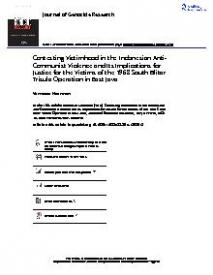Contesting Victimhood in the Indonesian Anti-Communist Violence and Its Implications for Justice for the Victims of the 1968 South Blitar Trisula Operation in East Java
Since the end of the Suharto New Order regime and Indonesia’s transition to democracy in 1998, the country has struggled to address past serious human rights violations, in particular the 1965–66 anti-communist violence. Half a million members and sympathizers of the Indonesian Communist Party (Partai Komunis Indonesia, PKI) and its mass organizations were killed and hundreds of thousands were detained, most without trial. Although these individuals seem to have the clearest claims to victimhood, they still cannot easily gain such recognition, facing opposition from the military and representatives of civilian organizations implicated in the violence.
The contested nature of the status of victim, and in particular how to accommodate claims from those who were less central to the experience of political persecution but who nonetheless suffered as part of the government and military’s anti-communist strategy, is the subject of this article. Drawing on scholarly literature on victims, victimhood and collective memory, I analyse a case study of a group of villagers in south Blitar, East Java and how their being implicated in providing support for leftist fugitives in that area in 1966–68 has influenced how they are perceived by society.
Representations of this group of villagers by the military and government have resulted in the rise of a collective victimhood across generations, but a victimhood that nonetheless remains striated by victim hierarchies and difficulties in identifying as victim. As a result of these factors, this complex victim group has, by and large, been excluded by mainstream transitional justice processes, except for limited efforts by two small non-government organizations in the local area, discussed in this article. The resurgence of anti-communism since the election of President Joko Widodo, however, creates new difficulties for the victims and these organizations.
In: Journal of Genocide Research, ISSN 1462-3528 ; eISSN 1469-9494 | 19 | 4 | 512-529
https://doi.org/10.1080/14623528.2017.1393943
This is an Open Access article distributed under the terms of the Creative Commons Attribution License (http://creativecommons.org/


